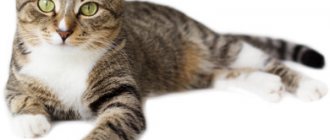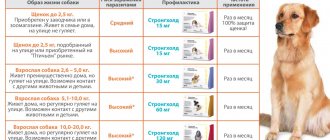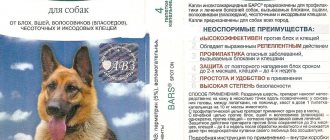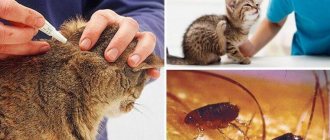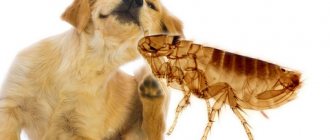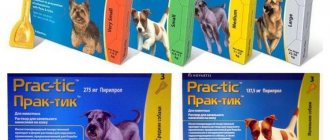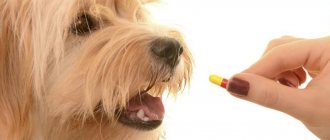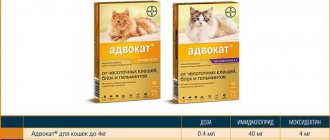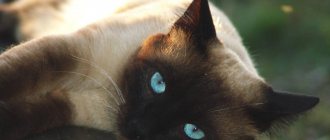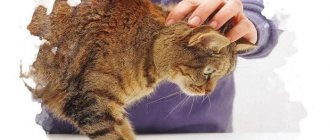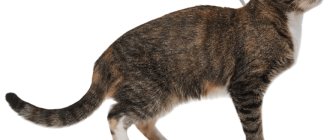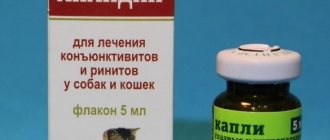Update date: 02/14/2021 14:36:52 11803 Share:
Author of the article: Astafieva Ekaterina Alekseevna
*Review of the best according to the editors of simplerule.ru. About the selection criteria. This material is subjective in nature, does not constitute advertising and does not serve as a purchase guide. Before purchasing, consultation with a specialist is required.
Flea drops are insecticidal preparations designed to kill harmful parasites. Products can be purchased at specialized animal stores or veterinary pharmacies. When choosing flea drops for cats, pay attention to the composition, because all substances used to kill insects have approximately the same mechanism of action. To help consumers make the right choice, experts from the online magazine Simplerules conducted market analysis, comparative tests, and studied customer reviews. The information obtained during the test allowed us to compile a rating of the best flea drops, including 11 nominees.
Operating principle and effectiveness of flea drops
Flea drops for cats are concentrated solutions containing substances with an insecticidal effect. They contain additional ingredients that ensure rapid penetration of the main component into the skin. Flea drops for cats spread evenly over the entire skin of the animal, penetrating into every hair follicle. What happens next:
- when an insect comes into contact with an insecticide, the latter is absorbed into its smooth body equipped with bristles;
- the toxic substance affects the flea’s nervous system, causing muscle paralysis and immobilization;
- the insect loses the ability to move and feed, and therefore soon dies.
Cats and kittens stop itching mainly in the first day after applying the drops. Insecticides are metabolized in the skin to substances that are harmless to the animal, and then naturally eliminated from the body.
What happens to fleas after treatment?
Drops have a detrimental effect on parasites in one of three ways:
- Impact on the nervous system, resulting in death.
- Contact action. A toxic substance with a poisonous effect penetrates the insect’s body through direct contact.
- Repellent effect. The smell of some products can only repel fleas, but will not lead to their destruction.
Protection from parasites.
In what cases do veterinarians recommend using drip medications?
Applying drops to the withers against fleas for cats is practiced everywhere in veterinary medicine. Thanks to this form of the insecticide, it almost completely penetrates the skin. For example, a stream of spray is sprayed several centimeters around. In addition, it ends up on those parts of the animal’s body that it can lick. Therefore, veterinarians recommend using drops to treat young cats and kittens that are unable to remain still for even a few minutes.
Interesting! These medications are well suited for both short-haired and long-haired pets. The insecticide does not wet the hairs, but is absorbed directly into the skin. Since fleas feed on the animal’s blood, they will certainly be immobilized within 24 hours.
| Characteristics of anti-flea drops for cats | |
| Advantages | Flaws |
| Ease of use | Temporary wool contamination |
| Rapid manifestation of effects | The presence of a pungent odor (for some insecticides) |
| Relatively low price | — |
| Low toxicity, high safety | — |
General recommendations for use
Information on the use of flea drops is described in detail in the instructions for each drug. Despite the fact that each has its own application features, there are recommendations common to almost all means:
- Do not bathe your pet several days before and after treatment.
- It is better to carry out the procedure in cloudy weather or in the evening to avoid direct sunlight.
- The composition should be applied to the withers, closer to the base of the skull, to prevent poisoning of the body from toxic substances getting inside. The composition is applied directly to the skin, pushing the fur apart. If it is recommended to apply the drug along the spine (usually this applies to domestically produced products), this should be done no lower than the middle of the body so that the cat cannot lick the medicine.
Important! Do not drop insecticides onto areas around the eyes or mouth, or allow them to get into the ears, mouth, or nose. In this case, rinse the affected area with plenty of water.
- Rub the composition into the skin to ensure even distribution and greater effectiveness.
- Do not comb your pet for 2-3 days.
- Handle and touch the cat less for a couple of days after the procedure to avoid toxic substances entering the human body.
Instructions for use
Drops against blood-sucking fleas are easy to use. It is necessary to adhere to the following algorithm of actions:
- lay the cat on its stomach, stroke it, calm it down, but at the same time hold it well;
- spread the fur on the withers and (or) back of the head - places inaccessible for licking;
- Apply the concentrated solution and gently rub it into the skin.
No preliminary preparation is required. But veterinarians recommend not bathing your cat for several days before the procedure. A sufficient amount of sebum will accumulate on the surface of the epidermis, which perfectly absorbs the insecticide.
Important! The cat should not have any microtraumas in the areas where the flea medication is applied - scratches, cracks, damage from bites of other animals. Otherwise, the insecticide will penetrate the bloodstream, which may cause side effects.
How to use drops for dogs
Where to put flea drops on a dog?
Usually flea drops are placed on the dog's withers. Whether you need to rub in the drops or not depends on the drug chosen. The hair on the dog's withers will need to be parted so that the drops also get on the skin. If the drops you use need to be rubbed in, then this should be done carefully and smoothly. And better use gloves. And try to apply the drops in the area of the withers where the pet cannot lick the drug.
How many drops do you need to apply?
Usually the required number of drops is indicated by the manufacturer in the instructions for use. Also, the dose of drops depends on the weight and age of the dog. Flea drops have yellow or brown tints and are in small pipettes and ampoules, and most often one pipette is designed for one-time use.
Next, the dosages will be analyzed, following the example of the drug Advantix. If your dog weighs less than 4 kilograms, then 0.4 ml of the drug is recommended. For animals weighing 4–10 kilograms, 1 ml is prescribed. 2.5 ml is enough if your dog weighs more than 40, but less than 25 kg. But for 40 kg of weight, you will need 4 ml drops.
In cases where the dog weighs more than 40 kilograms, the following formula is used - 0.1 ml per 1 kg of body weight.
Which dogs should not receive flea and tick drops?
Flea drops should not be used:
- sick dogs - you need to wait for the pet to fully recover;
- puppies less than seven weeks old;
- small dogs whose weight does not reach one and a half kg, in this case, need to consult a veterinarian to prescribe an alternative method of treatment;
- also, some dogs cannot tolerate the substances that make up the drops;
- The use of drops is excluded for pregnant and lactating dogs, consult your veterinarian.
Nuances and rules for safe application of the drug
The owner must protect not only the cat, but also himself from the negative effects of the insecticidal drug. Processing must be carried out with thin gloves. If you are prone to developing allergic reactions, you need to wear a medical mask and then throw it away. To increase the effectiveness of the treatment procedure, you should use the following tips:
- Before treating a large animal, you should contact your veterinarian to calculate the dose of the drug.
- You need to use a pipette, which is equipped with a flat plastic bottle, to evenly distribute the product on the skin. It is also very convenient for counting drops when treating kittens.
- After the procedure, you should not bathe the animal for three to four days.
Larger cats are given a larger amount of solution, distributing it throughout the spine. After the procedure, they immediately have a desire to lick the drops, which can lead to intoxication. It is advisable to place your pet in a carrier for a couple of hours and wait until the insecticide is absorbed.
Attention! Situations when a cat is frightened by the owner’s manipulations, breaks out and hides are not uncommon. You shouldn’t catch it and try to complete the procedure. Application of the remaining drug can be continued after the animal has calmed down.
How long before you can wash after applying drops?
The period before washing a cat after flea treatment depends on the composition of the product used. It takes 1-2 days for a water-based product to absorb, and about 5 days for an oil-based product.
If you notice allergy symptoms (itching, redness, fresh scratching), your cat should be bathed immediately. A local reaction to the use of the drug can cause irreversible consequences that will require urgent treatment of the animal.
In order not to harm the cat and to be sure that the necessary protective layer has been formed, it is recommended to use the drops 2-3 days after bathing. In some cases, this period is 5 days.
Contraindications and side effects
An absolute contraindication to the use of flea drops is individual intolerance to the components. To determine hypersensitivity, you should first apply a minimum amount of the product to the withers. If the animal feels well during the day, the skin does not turn red or swell, then you can begin the procedure. It is recommended to also consult a veterinarian to identify intolerance. The list of contraindications for drugs from some manufacturers also includes:
- poor health of the pet due to infectious diseases or exacerbation of chronic pathologies;
- low body weight;
- pregnancy, lactation.
Do not give your cat other means to kill fleas or other insects at the same time. An overdose will occur - a condition that threatens not only her health, but also her life. And if the recommendations for use are not followed, there is a high risk of side effects: shortness of breath, paw twitching, attacks of nausea, often ending in vomiting, diarrhea.
Vet advice! If any side effect occurs, it is necessary to wash off the insecticide from the skin, and then immediately contact a veterinary clinic for medical help.
Advantages over other insecticidal drugs
suppress the onset of fleas , ticks , and intestinal parasites in a variety of ways. But if you want to get rid of unwanted guests as soon as possible and for a long time, insecticidal drops will be the best remedy .
The popularity of such tools can be explained simply:
- All types of drops are produced in special dropper pipettes . Thus, calculating the dosage of the drug is significantly simplified;
- You can treat a cat captivated by fleas even without outside help;
- most drop manufacturers exclude the possibility of re-infection with parasites within several months after using the product.
Review of the best drops for fleas in cats
All modern means for killing fleas in cats combine high quality with safety. Before going on sale, all necessary laboratory tests and clinical experiments were carried out.
However, some drugs are more in demand than others. They are inexpensive, act quickly, and practically do not provoke the development of adverse local and systemic reactions. Below is a rating of the most popular insecticides in the form of drops for cats.
Rating of flea collars for cats: selection criteria and rules of use, read more in this article.
Beaphar
This is a clear, thick solution without foreign matter, with a slight odor and the active ingredient diazinon. The principle of action is based on damage to the locomotor system of fleas, through paralysis, which leads to their death within 24 hours. Additional components included in the complex penetrate into the deep layers of the skin, exhibiting antimicrobial and regenerating activity.
Hartz
An insecticidal agent designed to quickly destroy ectoparasites and prevent their reappearance within a month. The effect is provided by the active component methoprene. After application, it accumulates in the sebaceous glands and dermis of the animal, providing a contact insecto-acaricidal effect.
Inspector
“Inspector” is an anti-flea agent, the active composition of which is fipronil and moxidetin. They are able to quickly distribute on the surface of the pet’s body, accumulating in the dermis and not being absorbed into the blood. Thanks to this complex universal effect, effective protection against parasites is noted, which eliminates re-infection for up to one and a half months.
RolfClub 3D
This is a clear, thick, amber-colored liquid containing fipronil, etofenprox, and pyriproxyfen. The mechanism of action of the insecticide is to block innervation. This leads to impaired coordination of movements, paralysis and death of parasites that occur upon first contact with the animal’s fur.
Stronghold
"Stronghold" is an insecticide in the form of a clear solution with selamectin. It is characterized by a wide spectrum of action. The product has a paralyzing effect on ticks and helminths. To kill fleas and prevent re-infection, the drug is used once a month.
"Advantage"
The drug containing imidacloprid is used to kill and prevent fleas. Suitable for regular treatment of pets that often walk outside or come into contact with other animals. Highly effective, eliminates fleas within 12 hours. Affects parasites at any stage of development.
"Advocate"
This is a combined antiparasitic drug for cats with the active ingredients imidacloprid and moxidectin from the group of insecticides. It is available in the form of a viscous thick solution in doses for kittens and cats. “Advocate” reliably protects pets from re-infection for several months.
"LEOPARD"
The composition of flea and tick drops for cats includes fipronil, diflubenzuron and dicarboximide. The active substances are evenly distributed on the body and are not absorbed into the bloodstream. They accumulate in the animal’s dermis and have an insecticidal effect and provide high-quality protection for the pet against fleas and ticks.
Bars drops for cats against fleas: read the instructions for use in this article.
"Bolfo-aerosol"
A solution for external use in the form of an aerosol with the active ingredient propoxur. Before using the drug, its contents are shaken, then the spray is sprayed. The product is ideal for treating bedding, beds, houses, and hammocks for cats.
"VetExpert Pro Insecta"
The action of the drug is based on the properties of the active ingredients thiamethoxam, pyriproxyfen and cyfluthrin. In combination, they disrupt the functioning of all insect life systems. This causes paralysis and death of fleas.
"Dana"
The main composition of the veterinary drug is represented exclusively by fipronil. The disinfecting effect of the product appears within a day and continues for one and a half months after one treatment of the cat. It is relatively safe, and side effects are rare in clinical practice.
"Prasicide-complex"
This is the name of antiparasitic drops for external use with praziquantel, ivermectin, levamisole, fipronil. Additional ingredients ensure their good absorption at the site of application and long-term presence in the highest possible concentration in the body. One-time use of drops guarantees protection for about a month.
"Frontline"
A thick, viscous solution of “Frontline” with fipronil is a quick, effective, convenient way to get rid of fleas. It is used monthly, since the active substance destroys all fleas for exactly this period. The result of using the product is observed for a month and a half, but the likelihood of re-infection appears after 30 days.
"Celandine"
A special feature of the medicine is its effectiveness against fleas at all stages of development - from eggs to mature individuals. The active composition of the insecticidal drug is fipronil and permethrin. It is recommended to use Celandine drops against fleas for cats in advance to prevent attacks by blood-sucking parasites.
For the little ones
It is worth removing fleas from kittens using drops only if they have been weaned from the cat and when the number of parasites threatens the health of the babies. It is important to remember that the insecticides included in the preparations can cause serious harm to a fragile child’s body .
Drops can only be used when the animal reaches two months of age . If the kitten has not yet crossed this age limit, it is better not to risk it and postpone the treatment process, or try to remove some of the parasites with a comb.
Today, there are several types of drops that can be used to treat small pets. These are the drugs:
- Celandine Junior (used from 8 weeks of age).
- Advantage (applicable at 10 weeks of age).
- " Frontline " (used from 8 weeks of age).
- Stronghold (used from 8 weeks of age).
We also recommend reading the article about the types of flea treatments for kittens.
Cat fleas are a real scourge both for the animal itself and for its owners. In addition to the above mentioned remedies, these parasites can be removed using tar soap and Advocate drops.
Reviews from veterinarians
N. G. Goryachev, veterinarian, Penza.
The high quality of drops for killing fleas has long been confirmed in practice. Cats tolerate them well due to gradual absorption into the bloodstream.
S. M. Klinyev, veterinarian, Voronezh.
I always prefer to prescribe drops to my pets. The therapeutic effect appears within an hour, and the result lasts for 2 months or more.
I.L. Doroshenko, veterinarian, Moscow.
Modern drops do not have the disadvantages of their predecessors. In my practice, there have been no cases where such remedies did not work and did not provide protection for the animal.
Methods of flea infestation
Most often, an animal becomes infected on the street, but even a domestic cat that has never left the apartment and has not been in contact with sick animals can become a victim of blood-sucking insects.
The main factor is the presence of eggs laid by fleas, which the owner himself can bring into the house, for example, on the sole of a shoe.
Close-up view of a flea.
Precautionary measures
The amount of active ingredient in modern drops is quite small, and they are relatively harmless to pets, so even if the cat accidentally licked them, you shouldn’t worry too much. The situation can be critical for health if a cat licks all of its kittens that have been treated with an insecticide, which can lead to severe poisoning. There is also a danger in cases where a kitten licks the remains of the product from another; they can have a stronger toxic effect compared to an adult organism.
Regardless of the composition used, it is important to monitor the cat’s reaction and the condition of its skin. In some cases, it can cause allergic reactions, which are accompanied by itching, and even hair loss and dermatitis.
Important! To reduce the risk of an allergic reaction, veterinarians recommend using half the recommended dose upon first use, and the second half a day later.
If, after applying the composition, your pet develops nausea, vomiting, shortness of breath, or an increase in body temperature and these symptoms do not disappear after 1-2 days, you should consult a veterinarian.
During the treatment of an animal, allergic reactions and irritations can also occur in humans, so the procedure should be carried out with gloves. If you experience a cough, sore throat, or irritation on your hands, it is recommended to drink as much water as possible and wash your hands thoroughly.
